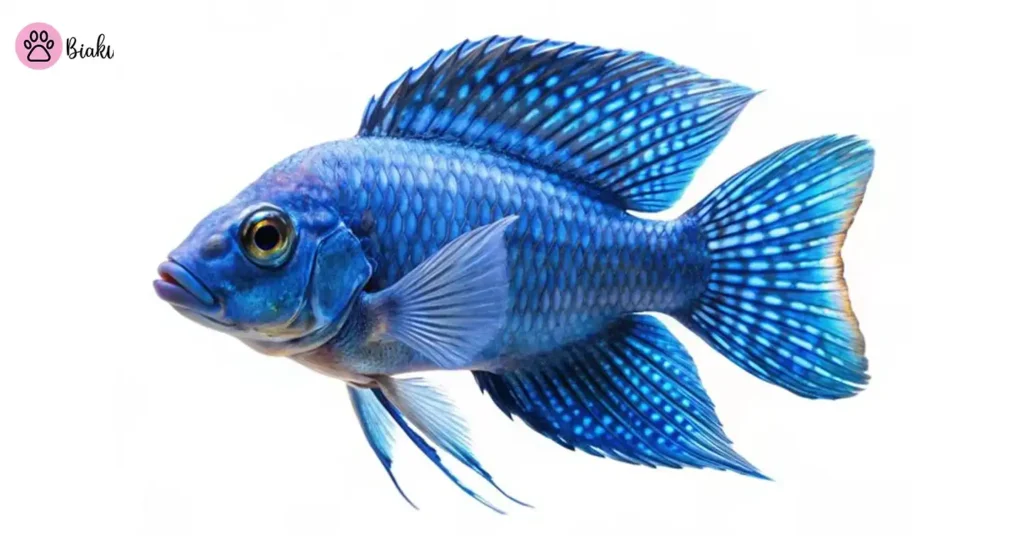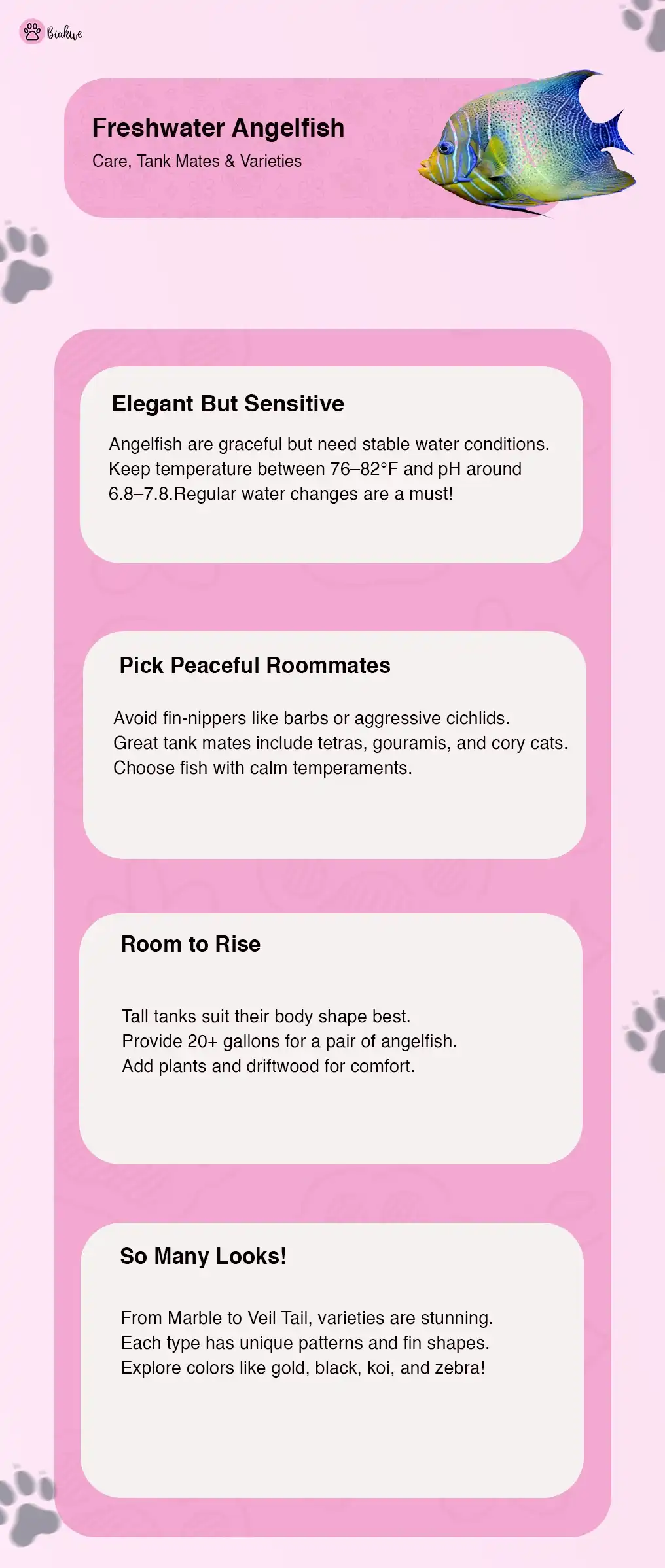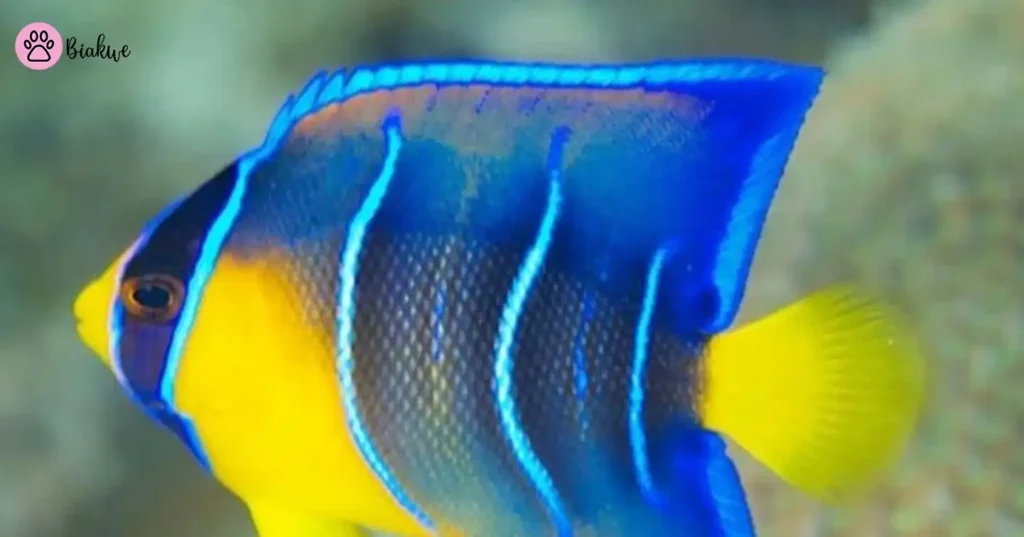Freshwater angel fish are one of the most popular species in today’s aquarium world. Their tall fins, graceful movements, and striking colors make them a favorite among both beginners and experienced hobbyists.
So, if you’re looking to learn about angel fish care, angelfish tank mates, or the many beautiful angelfish types, this blog has everything you need.
Why Choose Freshwater Angelfish?
Angelfish, freshwater species (Pterophyllum scalare), are known for their calm nature as well as their stunning beauty. Freshwater angelfish are easier to care for and more affordable in comparison with angelfish sea varieties.
- They live well in community tanks.
- Easy to feed and breed.
- Come in many stunning color patterns.
Angelfish are a great choice for people setting up their first aquarium, as well as for those who want to add a new mate to their tank.
Discover: Amstaff American Staffordshire: Complete Breed Guide for Owners
Angelfish Lifespan and Growth
Understanding the angelfish lifespan is important before bringing them home. With proper care, they can live up to 8–9 years. However, stress, poor water quality, or a bad diet can reduce their life expectancy to under 4 years.
How big do angelfish get?
- Most grow to about 12–15 cm (4.7–5.9 inches).
- Males can have longer fins and may grow slightly larger.
- They reach adult size in 12 to 18 months.

Angel Fish Care: What They Need to Thrive
Taking care of angelfish pets isn’t hard, but consistency is key. Here’s what you need to provide:
Water Quality
- pH between 6.0 and 7.0.
- Temperature: 24°C to 28°C (75°F to 82°F).
- Weekly testing for ammonia, nitrates, nitrites, and pH.
- Change 25–50% of water weekly.
Tank Setup
- Use a tank that’s at least 40 cm (15.7 inches) tall.
- Include live plants and hiding spots.
- Add a gentle filter to reduce current.
Diet
- Feed them a mix of flakes, pellets, and frozen or live foods.
- Baby brine shrimp and bloodworms are excellent protein sources.
Check this out: Pet Boarding Review 2025: Is Petshotel the Right Choice for Your Pet?
Angelfish Tank Size & Stocking Guide
Choosing the right angelfish tank size is very important. These fish are tall and need vertical swimming space.
Recommended Tank Sizes:
- 50L / 13 gal: 1 angel fish
- 100L / 26 gal: 2 fish
- 150L / 39 gal: 3–4 fish
- 250L+ / 66 gal+: 4–8 fish
Always avoid overcrowding. The bigger the tank, the better for water quality and fish health.

Best Angelfish Tank Mates
Angelfish tank mates should be peaceful and not too small (they might get eaten!). Avoid fin-nippers like tiger barbs.
Good Tank Mates Include:
- Corydoras catfish
- Mollies
- Swordtails
- Gouramis (non-aggressive types)
- Larger tetras (like black skirts or congos)
Stick to species that match their water needs and don’t compete for space.
Explore: Can Dogs Have Catnip? What You Must Know Before Sharing
Angelfish Varieties You Should Know
Thanks to selective breeding, there are many stunning angelfish types available today. Some are colorful, others have unique fins. Here are the top angelfish varieties:
- Golden: Light yellow body, sometimes shimmery.
- Silver: Classic look with black stripes.
- Koi: Red and white with random black or gold spots.
- Smoky: Half silver, half dark grey or black.
- Black: Solid dark body and fins.
- Black Lace: Elegant stripes over a dark body.
- Zebra: Like the silver type, but with more stripes.
- Marble: Black and white swirled like marble.
- Blushing: White fish with red patches near the eyes.
- Blue Blushing: Light blue-gray with darker outlines.
- Veiltail: Long, flowing fins. Comes in many colors.
These types not only look beautiful but also add variety to your tank. Mixing types can result in unique offspring if you decide to breed.
Breeding Angel Fish
Breeding angel fish is exciting and rewarding. A bonded pair will lay eggs on flat surfaces. If the eggs turn white, they may be unfertilized or infected.
Tips for Successful Breeding:
- Keep water clean and slightly acidic.
- Use methylene blue to prevent fungus.
- Reduce water flow so males can fertilize better.
- Move the fry to a separate tank for safety.
Fry grows fast with proper food. Baby brine shrimp work best in the early stages.
Selling or Sharing Your Angelfish
Each spawn can produce 100–1000 babies. Most aquarists can’t keep them all. Selling or giving them away is a great option.
Angel fish price depends on size and variety:
- Juveniles (2–3 cm): $0.50 to $1.00 each
- Adults or rare types: $30–$40+ each
Tips for Selling:
- Wait until fry are 2–3 cm long.
- Take clear photos and show parent fish.
- Use oxygen-filled bags or containers for transport.
You can also donate extra fry to schools or local hobbyists. It’s a great way to give back.

Common Health Issues
Freshwater angelfish species are hardy, but they can get sick, too. Watch for:
- White eggs: Likely unfertilized or fungus-infected.
- Color loss or skin holes: May be bacterial or fungal infection.
- Clamped fins or sluggishness: Could signal poor water or disease.
What to do:
- Quarantine sick fish.
- Use antibiotics or fungicides as needed.
- Improve water quality immediately.
Long-finned types like Veiltail or Blue Blushing are more sensitive, so keep their tank extra clean.
Learn More: Red Tailed Hawk: Diet, Sounds and Facts to Know
Fun Facts About Angel Fish Freshwater Species
- They belong to the cichlid family.
- They form pairs and may care for their young.
- They can recognize their owners over time.
- Juveniles often show different colors that change as they mature.
These behaviors make angelfish pets even more enjoyable to watch.
Conclusion
Freshwater angel fish are more than just pretty fish. They are interactive, intelligent, and adaptable. With proper angel fish care, you can enjoy their beauty for years.
From understanding angelfish tank size and best mates, to exploring gorgeous angelfish varieties, you’re now ready to provide the best home for your fish.
Whether you’re a beginner or an experienced fish keeper, these elegant creatures can bring joy, challenge, and a sense of accomplishment.
Start your angel fish freshwater journey today. They might just become the stars of your aquarium!
